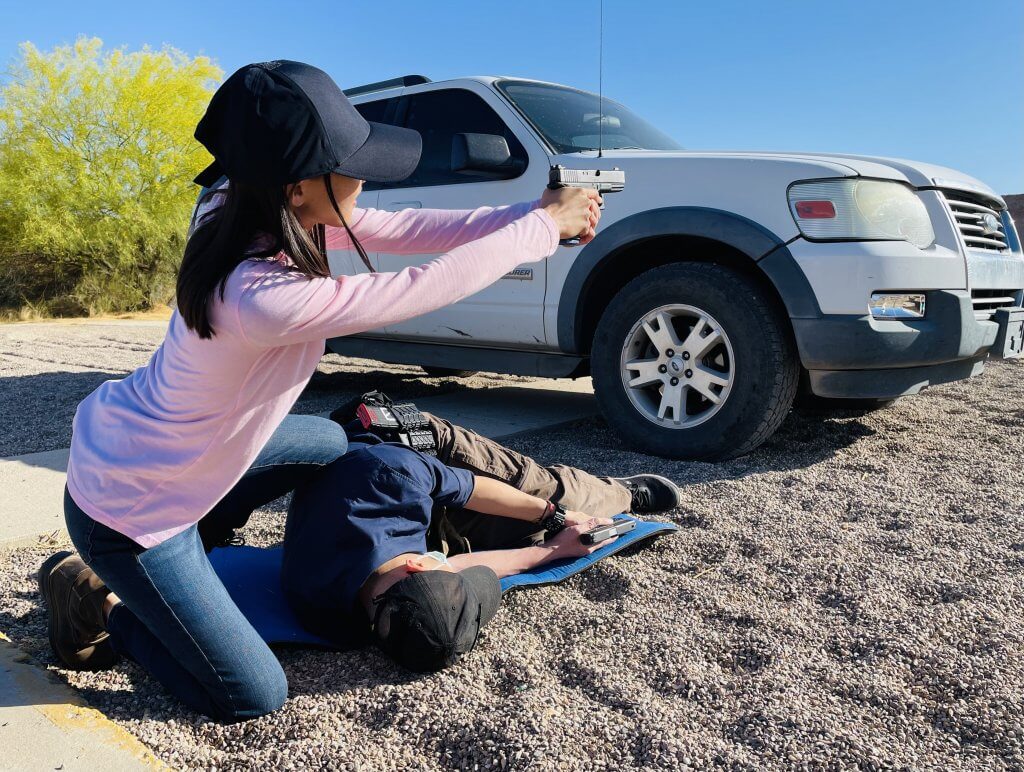Adam Johnson Held His Horses
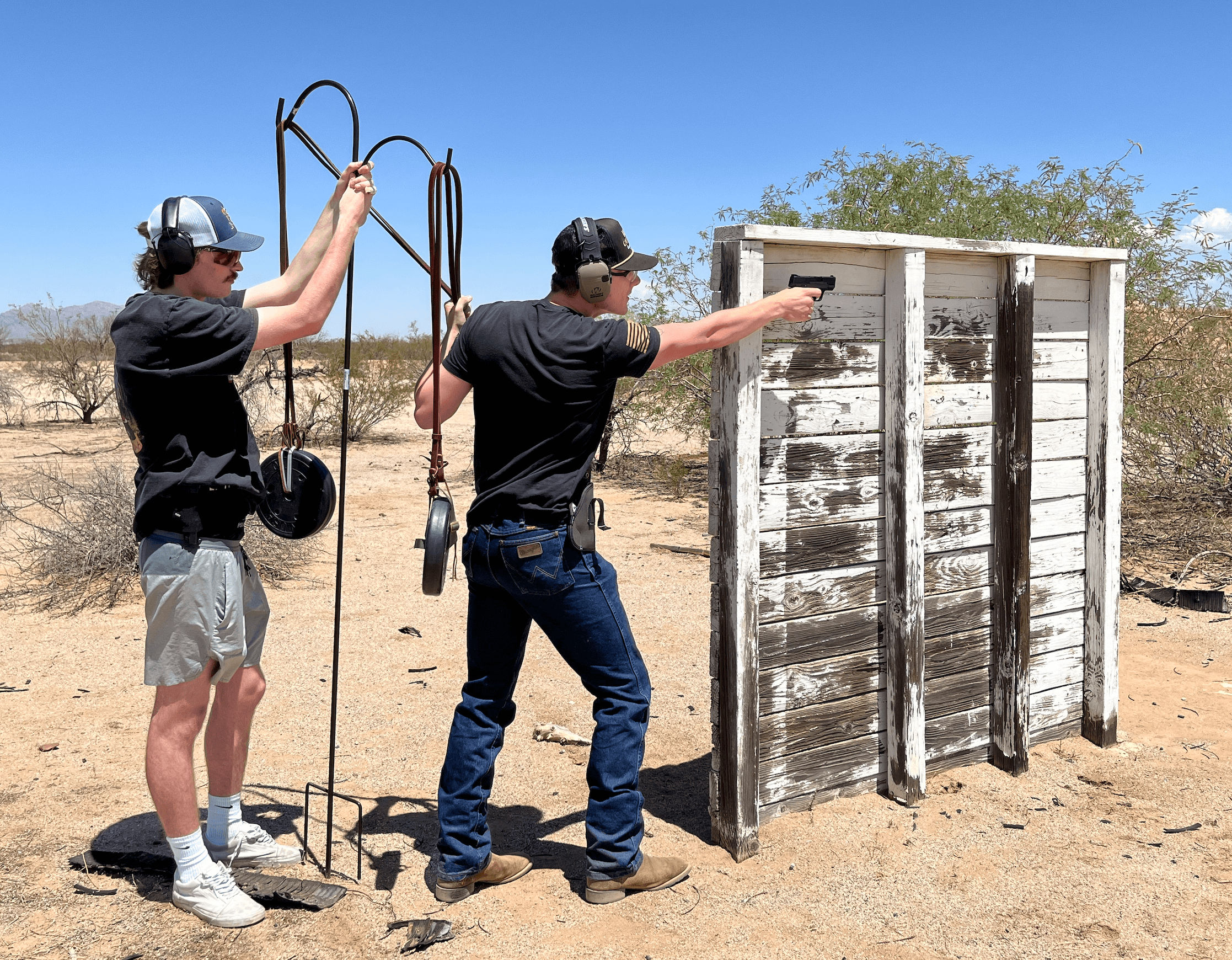
I went to the scene of this shooting in July, 2018. A friend who was familiar with the facts of the case showed me the relative locations of the antagonists. Sgt Johnson really did it at 104 yards.
We first set up this drill, as an homage to Johnson and the other officers who responded to that rampage, in May of 2025. Mark Pixler, for decades the editor of Dillon’s “Stealth Catalog,” graciously agreed to publish this writeup of Johnson’s incredible feat, and our attempts to recreate some of those shooting conditions, in The eBlue Press.
Here is the text of the article as it first appeared on pages 42 – 44 of the October, 2025 edition, under the title “Repeating the Feat: Hold Your Horses.” This version has additional photos and photo captions that were not in the original publication.
*****
Repeating the Feat, vol. 2
A society that ignores or forgets its heroes will not long endure. In this second installment of Repeating the Feat, we replicated the shooting problem faced by Austin PD Sergeant Adam Johnson, whose 15 minutes of well-deserved fame was confined mostly to Texas in late 2014.

THE RAMPAGE
It was 0218 hours on Black Friday of Thanksgiving Weekend. Horse patrol officers, including Johnson, were at the west end of a parking garage north of “Main,” the Austin, Texas police headquarters. They were getting ready to stable their equines at the end of their shift.
An extremist stepped out of a white van across from Main, and began shooting an Arsenal SLR-95 Kalashnikov pattern rifle at the police station. The noise echoed off the walls of the buildings.
THE RESPONSE
Although they were a hundred yards away, some horses spooked and ran. Johnson was trying to control his own horse when another horse patrol officer, Mike Wade, handed the leader of his horse to Johnson. Wade started running toward the extremist. That’s what cops do: when most people would run away, they run in. The bad guy turned his gun toward Johnson and other officers, hosing off at least five shots.
THE RESOLUTION
Sgt Johnson later said he was thinking about the people inside the station. He could see the extremist. In the dim illumination of the streetlights, the muzzle blast from the rifle seemed to be huge. Although the two horses Johnson held were police trained, they were hearing and seeing the rifle fire and jumping around a bit, pulling erratically on the leader / reins in Johnson’s support hand.
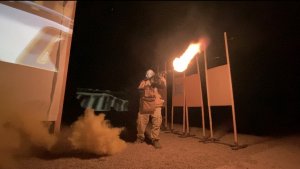
Johnson had a clear line of fire. He unholstered his Smith & Wesson M&P .40 and took aim one handed. He may have braced his wrist against the corner of the parking garage. Johnson took a deep breath and focused on his front sight. He fired one shot.
Johnson’s bullet hit the rampage shooter’s heart, at a measured distance of 314 feet, dropping him right there.

*****
SETTING UP THE DRILL
We used a full-sized steel IPSC silhouette. The most distance we could stretch out of our firing range was 274 feet, about 9 yards shy of 100.

A vertical barricade isn’t hard to set up, but it needs to be sturdy. Stacked barrels probably wouldn’t provide enough stability. Our range had a nearby obstacle course with a convenient wall.
Most of us don’t have one horse, much less two. Unless you compete in CMSA, the Cowboy Mounted Shooting Association (check out Robin Taylor’s outstanding article on Kenda Lenseigne in the May 2015 Blue Press), you’re even less likely to have a pair of horses trained to ignore the sounds of gunfire.
Real horses would be inconsistent at best, perhaps even dangerous. Instead, we hung two pairs of leather reins over a “2-tier double offset shepherd hook,” which is a Y-shaped garden pole one could use to hang lamps, potted plants, or hummingbird feeders. To simulate each horse trying to pull away, or at least needing to be held, we hung a 10-pound barbell weight from each pair of reins.
Before (literally) handing them the reins, we let each shooter practice till they hit, so they knew it could be done at that distance.

When they were ready, the assistant holding up the pole handed the reins to the “replicator” (your replicators could be students, shooting buddies, or competitors). Holding the reins in their support hand, the shooter:
- Drew,
- braced their wrist or hand against the barricade,
- took careful aim, and
- shot till they got a hit.

For safety, the assistant took the reins again before the participant reholstered. The biggest danger in our version of the event was a shooter potentially dropping a weight on someone’s toes.
SCORING
We did not run a timer. Rather, each replicator’s score was how many shots it took before they got a hit. Fewer is better. In the event two or more of your shooters hit with their first round, you could switch from a full-sized IPSC silhouette to a smaller “Q” (milk bottle) target, and have a shoot-off.
*****
A HANDGUN CAN DO IT–BUT SHOULD YOU?
Most fights happen at close range. You are not likely to be mugged by anyone with a bullhorn from across the street. But as the late, great Louis Awerbuck pointed out, if you’re going to be the exception to the rule by being in a gunfight at all, you might as well plan on being an exception to other statistics as well.
Longer shots are generally inadvisable, but they’re occasionally justified by extraordinary circumstances—provided you have the skill to pull them off. For example,
- 17 July 2022: Elisjsha Dicken hit a rifle-armed rampage shooter with 8 out of 10 shots from his Glock 19 at 40 yards, in the Greenwood Park Mall. [See post-script for details]
- 20 June 1994: Airman Andy Brown hit a rifle-armed rampage shooter between 71 and 68 yards away (the subject was advancing on, and shooting at, Brown) with 2 out of 4 shots from his issued Beretta M9, outside the Fairchild AFB hospital.
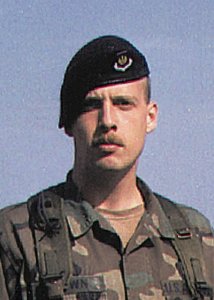
104+ yards is clearly the domain of the rifle / carbine, but Johnson didn’t have one handy. You may not have one either.
When I taught firearms for the Border Patrol, we would pound out our quarterly qualifications in the morning, then run “stress courses” in the afternoon. At the end of the day, we would put a bowling pin on a post at 100 yards.
Massad Ayoob pointed out that one of the best ways to prepare for the stress of shooting under real-world pressure is shooting under match pressure. Any time you pull a trigger in practice, Mas said, something should be riding on it.
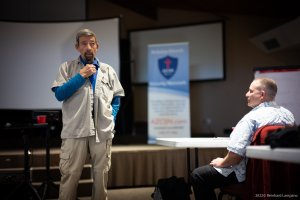
On advice of my attorney, I can neither confirm nor deny gambling on government time, but legend has it that we took turns shooting at the bowling pin with our Beretta 96Ds, for a dollar a try. First one to hit it took the pot. Then we’d set it up again and start over, until most of us had hit the pin enough to know we could take a hundred-yard shot if necessary. Afterward, whoever wound up hitting it the most would buy the cervezas for choir practice.
Later in my career, we’d set up a steel target at 70 to 100 periodically, so our special agents would be confident they could handle a long-range pistol shot if they ever needed to. I learned that at such distances, two things that can help you hit are stabilization and holdover.
STABILIZATION
Movement to cover is often a good default response to ambush. In medium-range situations, it’s better to stay back from one’s cover and roll out or pop up over it to return fire. Shooting over a barricade exposes more of your head but gives you better awareness of your battlespace. With a pillar or corner of a wall, like the Austin parking garage, you will have to “slice the pie” around it, rather than over it, which exposes less of you (the eye you’ll use to aim is closer to the side than to the top of your head). Unfortunately, such vertical barricades also blind you to what’s on the other side of the pillar, unless you have a partner covering around the opposite side of the pillar or wall. On 07 July 2016, Dallas Transit Officer Brent Thompson paid the ultimate price to teach us this lesson.

At distance, it’s harder for him to hit you, and you’ll need more stability to hit him. Going prone and bracing your support palm against the ground may work. Andy Brown used an elbow-supported kneel. Neither was an option for Johnson, holding the horses. If you have vertical cover to hide behind, like a pillar or the corner of a wall, it may be worth the tradeoff of exposing a little more of yourself (to both direct fire and ricochets off the wall), for a little longer, by bracing your wrist or the back of your hand against your cover to steady your aim. Press LIGHTLY against the barricade; firmer pressure will induce windage variation. Avoid gun-to-barricade contact.
Most firing ranges require your muzzle to be closer to the target than anything simulating cover, to avoid damaging barricades.

HOLDOVER
“Red dot” sights have made hitting distant targets with a handgun easier than ever. Pistol optics existed in 2014, but were not common on police sidearms then. Johnson had iron sights. Johnson said his front sight post “almost covered his [the bad guy’s] entire silhouette.” The post would have been wider than what he was shooting at; his sight picture would only have shown the upper quarter or so of the threat.
There are two holdovers to consider with handguns at distance.
The first is compensating for gravity and the arcing trajectory of the bullet. Most pistol projectiles shoot flatter than you can hold out to about 60 or 70 yards, but beyond 80 bullet drop becomes noticeable. You can easily look up ballistics charts that will list drop for your load, barrel length, and chosen zero distance (say, 25 yards). For 9x19mm or .40, it’s usually 7 to 12 inches below sightline at 100 yards. With .40, leveling the top of your front sight with the target’s shoulders at 100 yards should drop your pistol bullets into the bad guy’s boiler room. With 9mm, aim upper center of mass.
The other type of holdover is Kentucky windage. By that, I do not mean compensating for wind. A crosswind will push fat, slow moving pistol bullets slightly left or right, but not enough to matter when using a handgun defensively at 100 yards.
In this context, Kentucky windage means that your sights may be slightly off. It may not even be noticeable at 15 yards but will be magnified at 100. If you are consistently hitting, say, a foot left of the target at long range, you need to aim that same distance (in this case, one foot off the target) in the opposite direction (right). Same goes for hitting higher or lower than you want to. With a dirt berm behind the target, you can get feedback from where the berm is hit. Bystanders may see impacts more clearly than the shooter. Don’t ask your RSO (range safety officer); if the RSO is doing their job, they’re looking at the shooter, not downrange.

It was after 2 am, so the streets of Austin were mostly empty. A backstop (rising ground) was directly behind the assailant, but there was an overpass and a building on top of the rise behind that. Johnson would not have taken a hundred-yard shot in a city if he didn’t have a clear line of fire, and didn’t know he could pull it off. You should not either.
Jeff Gonzales says the best bullet trap is your assailant. Don’t shoot if you don’t have a reasonable chance of putting your bullets into the bad guy(s). That mostly depends on your skill. If the distance is beyond your ability with the weapon in your hands, you should seek cover and call 911 instead of adding more stray bullets to an already dangerous mix.
A quality handgun is capable of hitting a stationary steel silhouette, or even a bowling pin, at 100 yards. Can you? In daylight, with all the time in the world? When the target is not trying to kill you, your friends, or strangers? Adam Johnson hit at 100, with one shot, at night, under life-or-death pressure–while holding two frightened horses.
Johnson believes God guided his bullet. I too am a man of faith, but I’m guessing God chose him because Johnson had practiced for the task at hand. When destiny, dharma, or dumb luck puts you in the wrong place at the wrong time, make sure you are already the right person for the job.
–George H, proud to have previously been a Texas lawman
*****
Postscript
I did not know these details of the Greenwood Park Mall shooting when I wrote this article for The eBlue Press, the text of which is copied verbatim above (photos and captions have been added to this blog).
It was widely reported that Eli Dicken hit the spree killer with 8 out of 10 shots at 40 yards. But the truth, as always, is more complicated. According to Dicken’s lawyer Guy Relford, via First 30 Seconds author LTCOL Ed Monk (US Army, ret), Dicken’s gunfight, like most, was dynamic. Both sides moved during the fight. Here is roughly how it went down.
- Emerging from the bathroom with a gun and four mags, the killer shot 24 rounds in 15 seconds, hitting five people.
- Dicken could not see the killer at first, but when the killer moved into view, Dicken pushed his girlfriend down behind cover and fired four rounds at a distance of 43 yards, hitting the killer twice.
- The killer stopped killing and retreated toward the bathroom hallway. Dicken pursued him.
- Dicken fired four more rounds at the killer at 22 yards, hitting the killer with every shot. The killer staggered into a darker section of the hallway.
- Dicken closed even more with the killer, firing two more times from a distance of 8 yards. He hit the killer with both rounds, ending him.
- Dicken spoke with unarmed mall security, who went outside to meet responding police and explain what happened. Mas Ayoob calls this “the welcoming comittee,” a vital step in the chain of ensuring you don’t get shot by reponding police after stopping a killer.
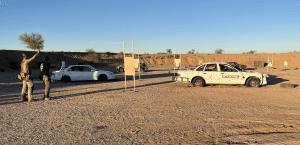
The data I published that Dicken hit with 8 out of 10 shots was correct, but not all of them were fired from 40 yards as the sources I referenced had reported. Four rounds were fired from farther than 40, and six were fired from closer. The bottom line? Half of Dicken’s four shots at 43 yards connected, ending the killing. His next four shots ended the spree. His last two shots ended the problem.

For more detailed information, read Monk’s book First 30 Seconds: The Active Shooter Problem, Americas Four Decades of Failure to Adapt, and What America Must Change to Minimize Victims (Last Resort Training and Consulting, 2025).
